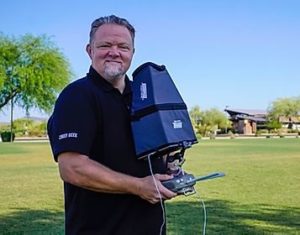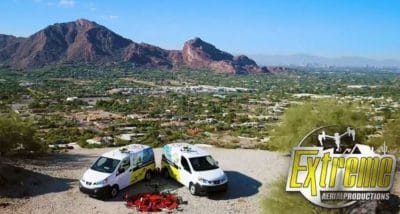Here is a terrific drone company question and answer interview with Mark Taylor, CEO Of Arizona based Extreme Aerial Productions.
Mark Taylor, CEO of Arizona-based drone company Extreme Aerial Productions, wasn’t always passionate about entrepreneurship and flying drones.
However, while working as a mortgage banker, he discovered the benefits of real estate drone photography to help drive sales for his agent partners.
Once Mark discovered drones, he never looked back. EAP was founded in 2014 and today works in all 50 states. EAP is FAA approved for commercial drone use. In this interview, Mark talks about his path to starting his drone company, advice for newbies and predictions for the future of drone operations.
Extreme Aerial Productions Top Drones
EAP work with the very best of equipment, using the Freefly ALTA 6 multirotor, DJI Inspire 2, Yuneec H520 and DJI Matrice 210 carrying various cameras. They also fly using the Mavic 2 Pro and Mavic 2 Enterprise.
For missions which cover larger distances, EAP also use fixed wing drones such as the FireFLY6 PRO and WingtraOne UAS.
EAP sure invest big in equipment and you can view their drone fleet here.
Drone Company Interview With CEO Mark Taylor Of Extreme Aerial Productions
 Special thanks to Stephanie Gordon, who works with EAP for this question and answer interview.
Special thanks to Stephanie Gordon, who works with EAP for this question and answer interview.
Q: What were you doing prior to working with drones?
Mark Taylor: “I was a mortgage banker for 25 years, and was looking for a way to leverage technology to add value to my realtor relationships. We filmed a house for a realtor so he could market it for sale.
An ad agency out of NY saw what we filmed and tried to hire us to do some filming for them. I honestly thought I was being punked when they called. They were really persistent.
We ended up shooting a project for them, and then began filming all over the country. That started my love of cinematography and I discovered drones from there.”
Q: What do you think makes EAP stand out among your competition?
MT: “There are tons of amazing editors and camera guys. But finding someone who’s both? That’s really difficult. At our company, we pride ourselves on the fact that the person who’s on your shoot can both understand and shoot the story.
Most production companies farm the editing out to someone who’s isolated in a cubicle. Not us. We made a commitment not to cut any corners, and have all the systems in one place.”
Q: How big is EAP currently?
MT: “We currently have eight team members. I originally wanted to keep it closer to three or more, but as the size of the projects we took on and client needs grew larger, we needed to expand our capacity.”
Q: What type of drone technology did you use early in your career?
MT: “As a kid, I originally started with radio-controlled planes. Then I got a Phantom 3, and after that I bought an Inspire 1.
Because of the fragility of the DJI ecosystem, we’ve found that we always need to have two UAS on hand at a time because there are always challenges. Ask any drone operator if they’d like to get away from DJI, and they’ll say “yes!”.
We’re now up to 19 UAVs. We still use DJI (Matrice 210, Inspire 2, Mavic 2, Mavic 2 Enterprise), but also have Autel, Yuneec, Wingtra, and FireFly as alternatives. We’ve spent around $300,000 on our equipment to date.”
Q: What advice would you give to someone just starting to fly drones?
MT: “Start with an Inspire 1 (try buying it used) and don’t fly it with GPS. Why? If you learn to fly manually without GPS, you’re going to be a safer, better, faster pilot. Everyone today is jumping on the Mavic 2, but it’s only really good if you know how to fly it.
When I got into drones, the barrier to entry was huge. You had to have a fixed wing pilot’s license, prove to production companies you had hours, and have the very best equipment and insurance.
Now, nobody seems to care. Some production crews will go to Best Buy when they arrive in town, give a drone to someone on their crew who has no idea how to use it, and off he flies. That’s a challenge in the industry today.
To win production business, you really need to prove you can fly and are worth what you are charging to prevent someone else from doing it themselves.”
Q: What would you tell someone who’s interested in starting their own company?
MT: “Take your time learning the craft and double the amount of equipment you think you’ll need. You’re going to need a backup aircraft no matter what.
Add an extra hour in time to every mission and be over-insured. With clients, you should always under promise and over deliver!
Lastly, start your company and do it all in cash. No matter what, do NOT go into debt. You won’t be able to keep up with technology changes.”
Q: Where do you see the future of drone technology heading?
MT: “Right now we’re heavily involved in tethered flights and we just received a waiver to fly over people. We’re also working beyond visual line of sight (BVLOS).
The market is going to be opening up for more stadium and sporting events.
It took us six months and $3,000 in equipment to originally get our waiver, but now more people are getting accepted by the FAA.
In the next six months, it’s going to be easy for anyone to get one. Unless the customer you’re working with is risk averse, it’s going to be harder for drone operators to sell their businesses.”
Q: What would you say is the biggest problem for drone companies today?
MT: “One thing we all struggle with as drone operators is that we need to have a nationwide accepted pricing norm for our services. Every client who calls me is price driven, not quality driven. It’s hard to justify our video production and experience (EAP has over 8,000 verified missions) when other people are willing to sell their services for next to nothing.
Drones save money and make money for companies. I would love to see a national base price in place for clients. For example, look at the price of a burger- we know what that’s going to cost us!
Why can’t we have the same? If a pilot has this much experience, is flying this unit for this long and is delivering raw footage, what is the “normal” acceptable fair market price? It’s hard when everyone says they can fly a drone and are willing to treat a business like a hobby.
When government agencies and states start fining operators for mishaps, I think that’s when things will change.”
Extreme Aerial Productions Showreel
Here is a sample of the outstanding work produced by EAP.

